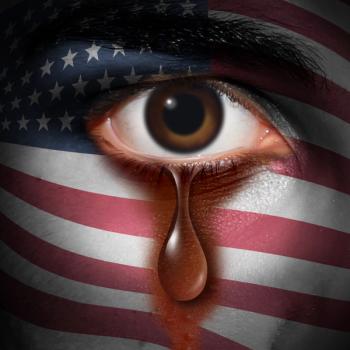
We Think We Have Problems? 5 Supernatural Entities the Premodern World Had to Worry About
Throughout history and across cultures, monsters have helped communities teach lessons and affirm their values.
There is no doubt about it. This has been an exhausting and stressful year. The global pandemic, rising unemployment, social distancing, the United States presidential election, wildfires, and then, of course, the so-called “
Perhaps we can take some small comfort, however, in the knowledge that our ancient, medieval, and early modern forebears successfully stared down threats and misfortunes on multiple fronts. Living in a world they understood to be teaming with ominous apparitions, imposing creatures, and dark forces, they faced not only artificial and natural disasters, but also calamities of a supernatural kind. So, consider these 5 monstrous entities with whom our ancestors had to share this terrestrial plane.
Demons
Some of the earliest written sources we have from Mesopotamia confirm that belief in demons (from the Latin daemones) is very ancient indeed. Throughout antiquity, demons were generally considered to be neutral supernatural beings, equally capable of helping and harming humans. When malevolent, however, they could be cunning and take on different forms. There are numerous tales from ancient China, for instance, of demon dogs who acted like or possessed human beings. For example, according to the politician and historian Ying Shao (140 to 206 CE), when a dog showed up after the spirit of a dead man who had been terrorizing a household seemed to leave, residents decided to cane the poor beast to death.2
In the Middle Ages, Europeans came to view demons as unequivocally diabolical, working, they believed, in concert with the Devil. Late-medieval writers spoke of demons, sprites, and goblins creeping around lakes, rivers, and mountains, killing miners, pestering animals, and luring men and women into damnable carnal relations.3 None of this talk, however, deterred most folk from continuing to appeal for aid from what were thought to be kindlier demons.
Ghosts
The ancient Greeks and Romans had a variety of names for what we call a ghost, including shade, manifestation, image, cloud, and breeze. Terms like these seem to suggest that ancient ghosts were perceived to be intangible, but in fact many were corporeal enough to eat, drink, hug, and even have sex. Tending to be either white or black in hue, they could appear as tiny winged creatures, 12-foot giants, or anything in between.4
What is consistent in tales about ghosts well into the 19th century is that they generally appeared in order to remedy an injustice: either the departed had not been properly laid to rest and now sought an appropriate burial, or the dead party demanded revenge for their murder or killing. Unsurprisingly then, old battlefields especially were considered sites of large numbers of angry and harrowing specters.5
Werewolves
Stories of human beings taking on the shape of a wolf also go back to antiquity, where it was believed that while some did so voluntarily, others were condemned to such fate as a punishment by a god. What made werewolves especially menacing and loathsome to the general public was the accusation that the creatures killed and devoured their human victims. In 16th-century Europe, suspicions that people were using magic to turn themselves into wolves led authorities to try, convict, and burn at the stake a number of individuals for the crime of lycanthropy.
One of the most infamous cases involved a German man known as Peter Stumpp, convicted and executed in 1589 for being a werewolf. Stumpp’s crimes were in fact quite gruesome, as he murdered at least 13 children and several men and women, apparently cannibalizing some of their bodies. As a punishment, he was tortured with hot pincers and had his flesh torn, his arms and legs broken, and his head cut off and displayed on a pike to ward off any other potential werewolves.6
Shapeshifters
Werewolves are perhaps the most recognizable shapeshifters, but they certainly were not the only ones. Folklore is replete with reports of a wide range of shapeshifting beings, usually humans turning into animals or inanimate objects. Not all were malicious, but many were. The Ukrainian vedmak, a male witch capable of becoming a horse, a moth, or an inanimate object, consorted with the Devil and was said to kill livestock, destroy harvests, and bring disease. Slavic lore spoke of the leshy, a woodland man with green eyes, hoofs, horns, and a tail. It was believed the leshy could transform himself into plants and animals and enjoyed kidnapping women, confusing travelers, and even sometimes tickling people to death.
Europe certainly has not been alone in chronicling accounts of shapeshifting malefactors. Ancient Japanese folklore mentions a malevolent, shapeshifter called the tanuki. Originally described as a racoon-like dog, the tanuki was thought to be able turn itself into a human form, haunting and possessing people. In a particularly grisly anecdote, a tanuki killed an old woman, then turned her into soup, after which the tanuki took on the form of the old woman and fed the soup to the dead woman’s husband.7
The Walking Dead
Ancient Greek sources speak of some magicians and witches having the ability to not only conjure and placate ghosts, but also raise the dead. There appears to be little to no evidence of individuals actually performing this art of necromancy. But descriptions of elaborate rituals succeeding in bringing corpses back to life, sometimes with grim consequences, were well known. In a particularly harrowing instance, a mother revivified her dead son, who then reprimanded her and predicted her imminent, violent death.8
Medieval Europe was also the location of numerous sightings of the risen dead, an occurrence featured in a number of Jewish sources. The writings of German-Jewish Pietists (Hasidei Ashkenaz) of the late 12th and early 13th centuries, for example, offer up a bounty of monsters and monstrous creatures (demons, dragons, witches, vampires, werewolves), including the walking dead.9 In most accounts, they proved to be quite friendly, even helpful. The fact, however, that most of these medieval zombies greeted the living with the refrain “I will not harm you” testifies to the fear they provoked.10
It might be tempting to look back at stories like these and dismiss them as superstitious nonsense. But it is important to keep in mind that identifying, imagining, interpreting, and discussing monsters have been preoccupations of cultures since recorded time. There are reasons for this. Our word “monster” derives from Greek and Latin terms referring to a portent or warning of some kind. Monsters are messengers, perceived to be bearers of messages of great importance. In this way, they give communities an opportunity to declare some of their most cherished values, to teach lessons, and to inspire heroism. Today, we too have our own monsters to face (both man-made and natural) and like our ancestors, we invariably will use them to consider, debate, and struggle for the things we hold most dear.
Dr Eghigian is professor of history at Penn State University. He specializes in the history of psychiatry and mental health and is member of the Psychiatric TimesTM Editorial Board.
References
1. Mike Baker. ‘Murder hornets’ in the U.S.: the rush to stop the Asian Giant Hornet. The New York Times. Updated November 13, 2020. Accessed November 24, 2020.
2. Roel Sterckx. The Animal and the Daemon in Early China. SUNY Press; 2002.
3. Petzoldt L. The universe of demons and the world of the late middle ages. In: Petzoldt R, Neubauer P, eds. Demons: Mediators Between This World and the Other. Peter Lang; 1998.
4.Ogden D. Magic, Witchcraft, and Ghosts in the Greek and Roman Worlds: A Sourcebook. Oxford University Press; 2009.
5. Davies O. The Haunted: A Social History of Ghosts. Palgrave; 2007.
6. Beresford M. The White Devil: The Werewolf in European Culture. Reaktion; 2013.
7. Kachuba, JB. Shapeshifters: A History. Reaktion; 2019.
8. Ogden D. Greek and Roman Necromancy. Princeton University Press; 2001.
9. Shyovitz DI. Unearthing the ‘Children of Cain’: between humans, animals, and demons in medieval Jewish culture. In: Monsters and Monstrosity in Jewish History: From the Middle Ages to Modernity. Idelson-Shein I, Wiese C, eds. Bloomsbury; 2019.
10. Shyovitz DI. The might of the living dead: thinking with zombies in the Jewish tradition. Paper presented at Workshop on Jewish Zombies, Penn State University, 26 October 2020.
Newsletter
Receive trusted psychiatric news, expert analysis, and clinical insights — subscribe today to support your practice and your patients.

















